audio Lexus IS250C 2012 Instrument cluster / LEXUS 2012 IS250C,IS350C OWNERS MANUAL (OM53A62U)
[x] Cancel search | Manufacturer: LEXUS, Model Year: 2012, Model line: IS250C, Model: Lexus IS250C 2012Pages: 632, PDF Size: 6.77 MB
Page 1 of 632

TABLE OF CONTENTS
1
1Before drivingAdjusting and operating features such as door locks, mir-
rors, and steering column.
2When drivingDriving, stopping and safe-driving information.
3Interior featuresAir conditioning and audio systems, as well as other interior
features for a comfortable driving experience.
4Maintenance
and careCleaning and protecting your vehicle, performing do-it-your-
self maintenance, and maintenance information.
5When trouble
arisesWhat to do if the vehicle needs to be towed, gets a flat tire,
or is involved in an accident.
6Vehicle
specificationsDetailed vehicle information.
7For ownersReporting safety defects for US owners, and seat belt and
SRS airbag instructions for Canadian owners
IndexAlphabetical listing of informat ion contained in this manual.
Page 2 of 632
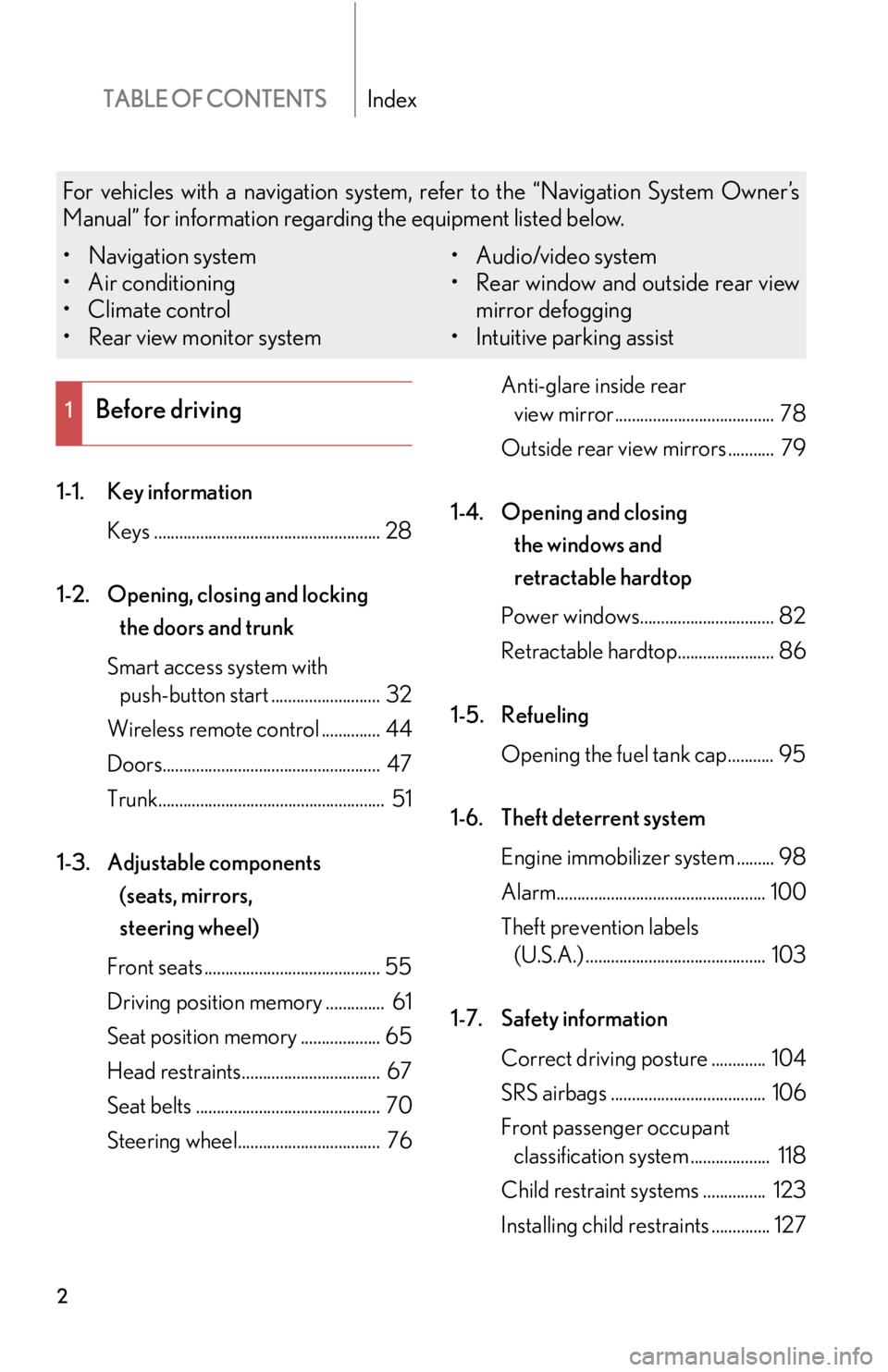
TABLE OF CONTENTSIndex
2
1-1. Key informationKeys ...................................................... 28
1-2. Opening, closing and locking the doors and trunk
Smart access system with push-button start .......................... 32
Wireless remote control .............. 44
Doors.................................................... 47
Trunk...................................................... 51
1-3. Adjustable components (seats, mirrors,
steering wheel)
Front seats .......................................... 55
Driving position memory .............. 61
Seat position memory ................... 65
Head restraints................................. 67
Seat belts ............................................ 70
Steering wheel.................................. 76 Anti-glare inside rear
view mirror...................................... 78
Outside rear view mirrors ........... 79
1-4. Opening and closing the windows and
retractable hardtop
Power windows................................ 82
Retractable hardtop....................... 86
1-5. Refueling Opening the fuel tank cap........... 95
1-6. Theft deterrent system Engine immobilizer system ......... 98
Alarm.................................................. 100
Theft prevention labels (U.S.A.) ........................................... 103
1-7. Safety information Correct driving posture ............. 104
SRS airbags ..................................... 106
Front passenger occupant classification system ................... 118
Child restraint sy stems ............... 123
Installing child restraints .............. 127
1Before driving
For vehicles with a navigation system, refer to the “Navigation System Owner’s
Manual” for information regarding the equipment listed below.
• Navigation system
• Air conditioning
• Climate control
• Rear view monitor system • Audio/video system
• Rear window and outside rear view
mirror defogging
• Intuitive parking assist
Page 4 of 632

TABLE OF CONTENTSIndex
4
3-1. Using the air conditioning system and defogger
Automatic air conditioning system ........................................... 248
Rear window and outside rear view mirror
defoggers ..................................... 257
Windshield wiper de-icer ........ 258
3-2. Using the audio system Audio system type ....................... 259
Using the radio .............................. 262
Using the CD player ................... 270
Playing back MP3 and WMA discs .................................. 277
Operating an iPod ...................... 285
Operating a USB memory....... 293
Optimal use of the audio system ........................................... 302
Using the AUX po rt................... 304
Using the steering wheel audio switches ........................... 306 3-3. Using the Bluetooth
®
audio system
Bluetooth
® audio system ........ 309
Using the Bluetooth
®
audio system................................. 312
Operating a Bluetooth
®
enabled portable player .......... 317
Setting up a Bluetooth
®
enabled portable player .......... 321
Bluetooth
® audio system
setup ............................................... 327
3-4. Using the hands-free phone system (for mobile phones)
Hands-free system for mobile phones ........................... 328
Using the hands-free system (for mobile phones) .................. 332
Making a phone call................... 340
Setting a mobile phone .............. 344
Security and system setup ........ 349
Using the phone book............... 353
3-5. Using the interior lights Interior lights list........................... 359
• Interior light ................................ 360
• Personal lights ........................... 360
3Interior features
Page 14 of 632
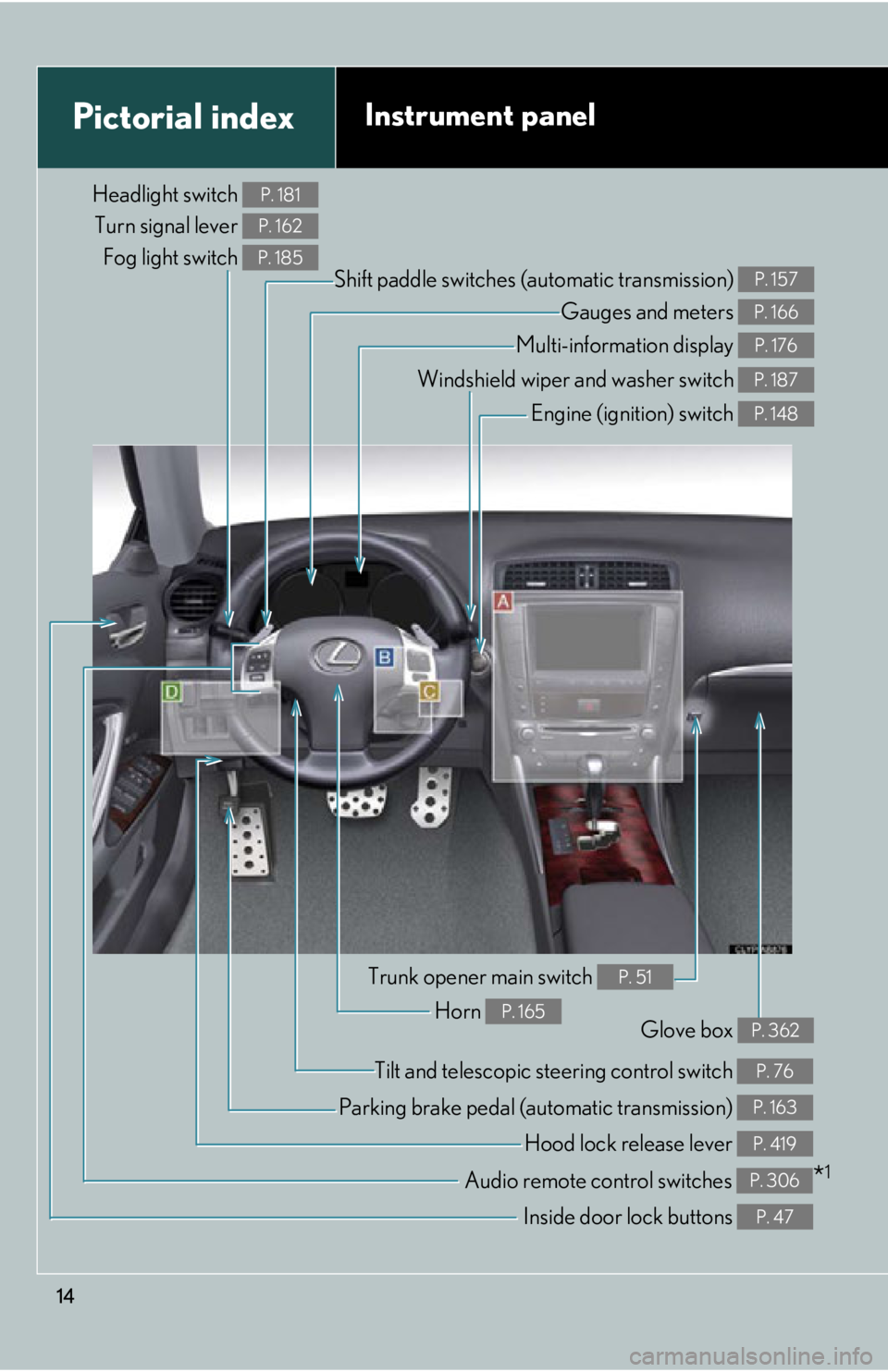
14
Pictorial indexInstrument panel
Headlight switch Turn signal lever Fog light switch P. 181
P. 162
P. 185
Shift paddle switches (automatic transmission) P. 157
Gauges and meters P. 166
Multi-information display P. 176
Windshield wiper and washer switch P. 187
Engine (ignition) switch P. 148
Trunk opener main switch P. 51
Tilt and telescopic steering control switch P. 76
Audio remote control switches *1P. 306
Horn P. 165Glove box P. 362
Parking brake pedal (automatic transmission) P. 163
Hood lock release lever P. 419
Inside door lock buttons P. 47
Page 15 of 632
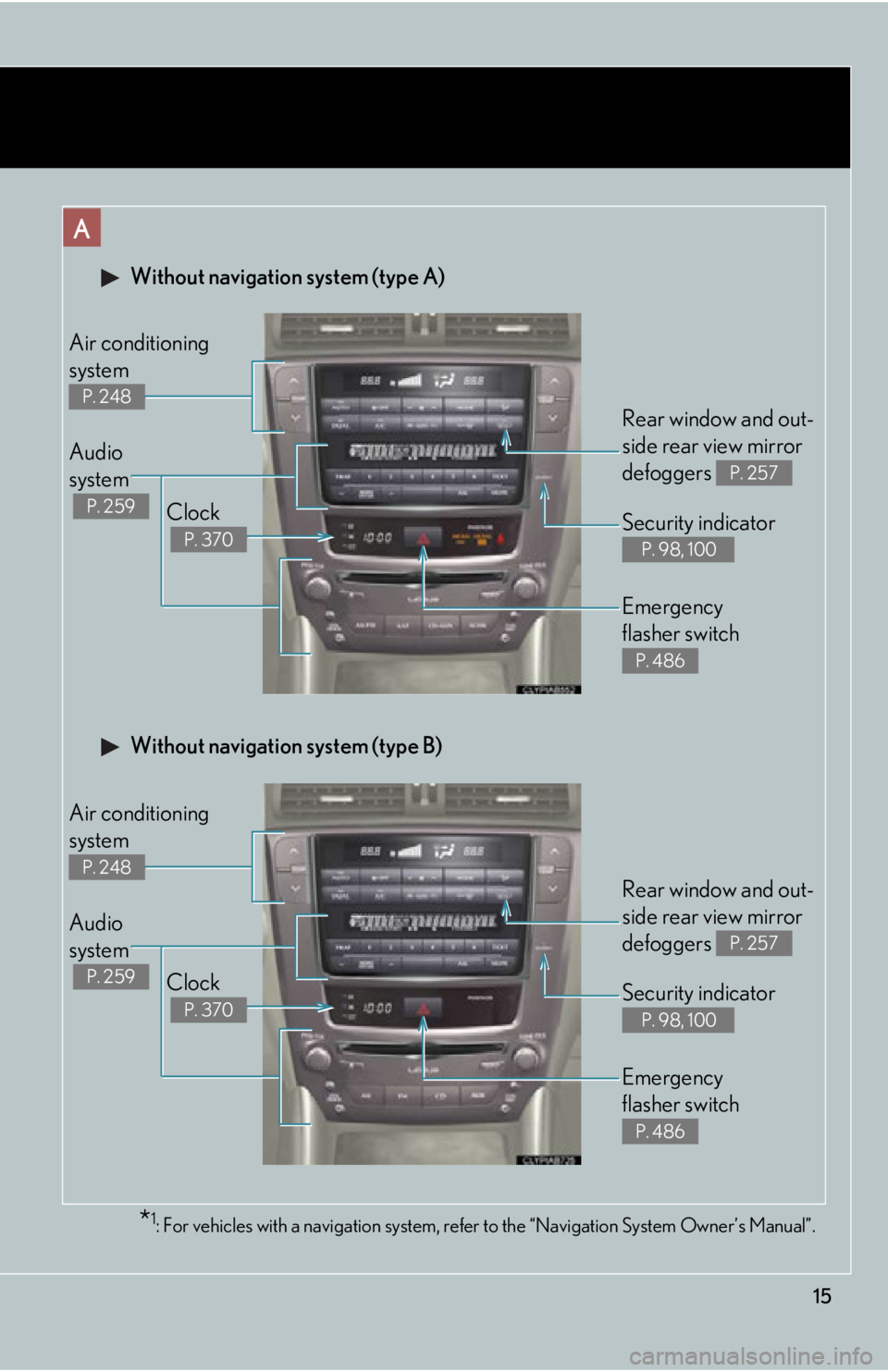
15
Without navigation system (type A)
Clock
P. 370
Audio
system
P. 259
Air conditioning
system
P. 248
Rear window and out-
side rear view mirror
defoggers
P. 257
Security indicator
P. 98, 100
Emergency
flasher switch
P. 486
*1: For vehicles with a navigation system, refer to the “Navigation System Owner’s Manual”.
A
Clock
P. 370
Audio
system
P. 259
Air conditioning
system
P. 248
Rear window and out-
side rear view mirror
defoggers
P. 257
Security indicator
P. 98, 100
Emergency
flasher switch
P. 486
Without navigation system (type B)
Page 16 of 632
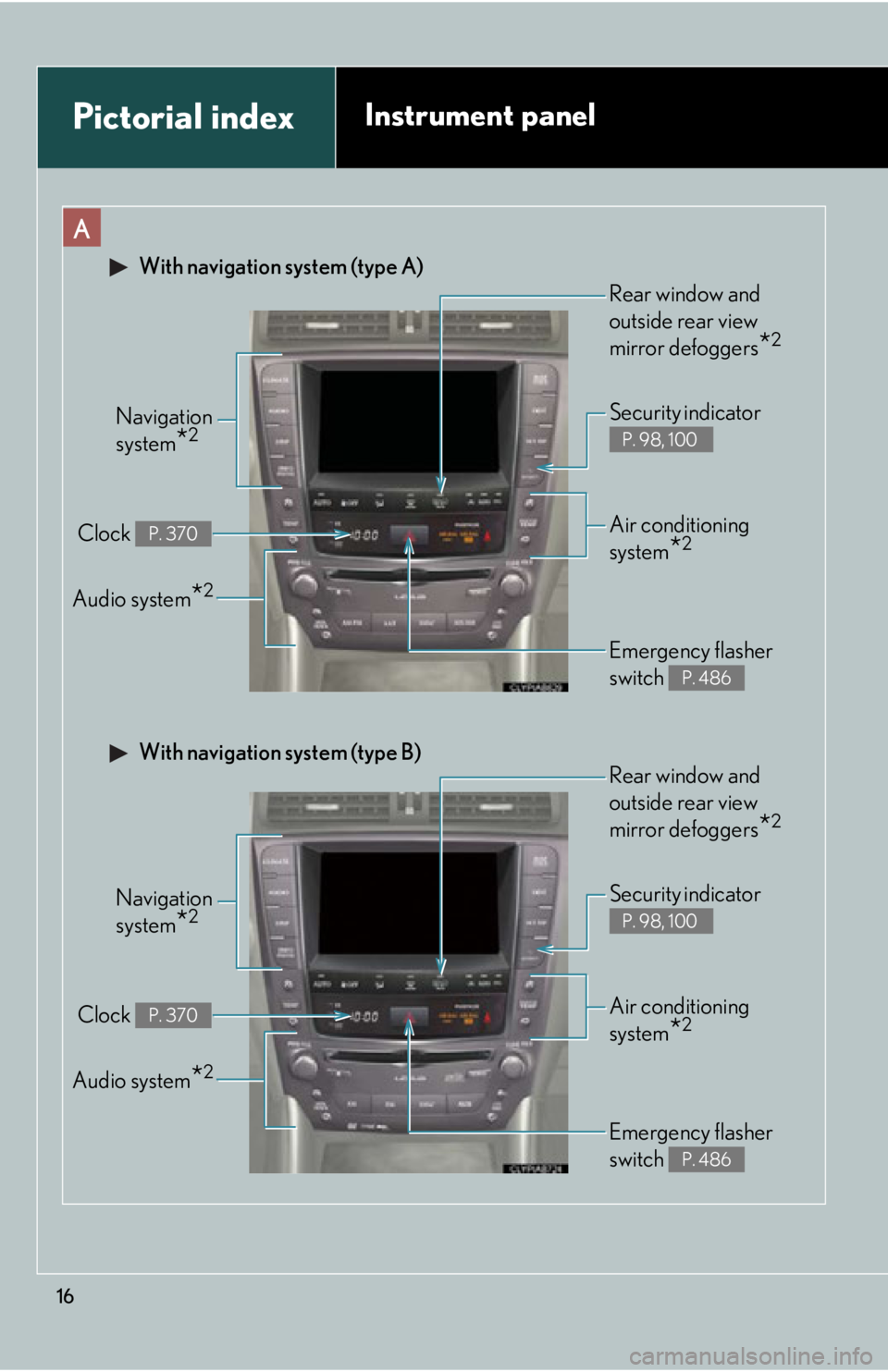
16
Pictorial indexInstrument panel
A
Navigation
system
*2
Clock P. 370
Audio system*2
Security indicator
P. 98, 100
Emergency flasher
switch
P. 486
Air conditioning
system
*2
With navigation system (type A)
Rear window and
outside rear view
mirror defoggers
*2
Navigation
system
*2
Clock P. 370
Audio system*2
Security indicator
P. 98, 100
Emergency flasher
switch
P. 486
Air conditioning
system
*2
With navigation system (type B)
Rear window and
outside rear view
mirror defoggers
*2
Page 31 of 632

31
1-1. Key information
1
Before driving
NOTICE
■To prevent key damage
Observe the following.
●Do not drop the keys, subject them to strong shocks or bend them.
●Do not expose the keys to high temperatures for a long period of time.
●Do not get the keys wet or wash them in an ultrasonic washer etc.
●Do not attach metallic or magnetic materials to the keys or place the keys close to
such materials.
●Do not disassemble the electronic keys.
●Do not place the keys near objects that produce magnetic fields, such as TVs,
audio systems, glass top ranges, or medical electrical equipment, such as low-fre-
quency therapy equipment.
■Precautions for handling the card keys
●Do not apply excess force when inserting the mechanical key to the card key.
Doing so may damage the card key.
●If the battery or card key terminals get wet, the battery may corrode and the card
key may stop working.
If the key is dropped into water, or if drinking water etc. is spilled on the key,
immediately remove the battery cover and wipe the battery and terminals. (To
remove the battery cover, lightly grasp it and pull.) If the battery is corroded, have
your Lexus dealer replace the battery.
●Do not crush the battery cover or use a screwdriver to remove the battery cover.
Forcibly removing the battery co ver may bend or damage the key.
●If the battery cover is frequently removed, the battery cover may become loose.
●When installing the battery, make sure to check the direction of the battery.
Installing the battery in the wrong direct ion may cause the battery to deplete rap-
idly.
●The surface of the card key may be damaged, or its coating may peel off in the
following situations.
• The card key is carried together with hard objects, such as coins or keys.
• The card key is scraped with a sharp object, such as a tip of mechanical pencil.
• The surface of the card key is wiped with thinners or benzene.
Page 36 of 632

36
1-2. Opening, closing and locking the doors and trunk
■Operation signals
A buzzer sounds and the emergency flashers flash to indicate that the doors have
been locked/unlocked. (Locked: Once; Unlocked: Twice)
■Conditions affecting operation
The smart access system with push-button start uses weak radio waves. In the fol-
lowing situations, the communication betw een the electronic key and the vehicle
may be affected, preventing the smart access system with push-button start from
operating properly:
(Ways of coping: P. 5 3 3 )
●When the electronic key battery is depleted
●Near a TV tower, electric power plant, gas station, radio station, large display,
airport or other facility that generates strong radio waves or electrical noise
●When carrying a portable radio, cellular phone, cordless phone or other wire-
less communication devices
●When the electronic key is in contact wi th, or is covered by the following metal-
lic objects
• Cards to which aluminum foil is attached
• Cigarette boxes that have aluminum foil inside
• Metallic wallets or bags
•Coins
• Hand warmers made of metal
• Media such as CDs and DVDs
●When multiple electronic keys are in the vicinity
●When another wireless key (that emits radio waves) is being used nearby
●When carrying or using the electronic key together with the following devices
that emit radio waves
• Another vehicle's electronic key or a wireless key that emits radio waves
• Personal computer or personal digital assistant (PDA)
• Digital audio player
• Portable game system
●If window tint with a metallic content or metallic objects are attached to the rear
window
●Immediately after the retractable hardtop is opened or closed
Page 150 of 632
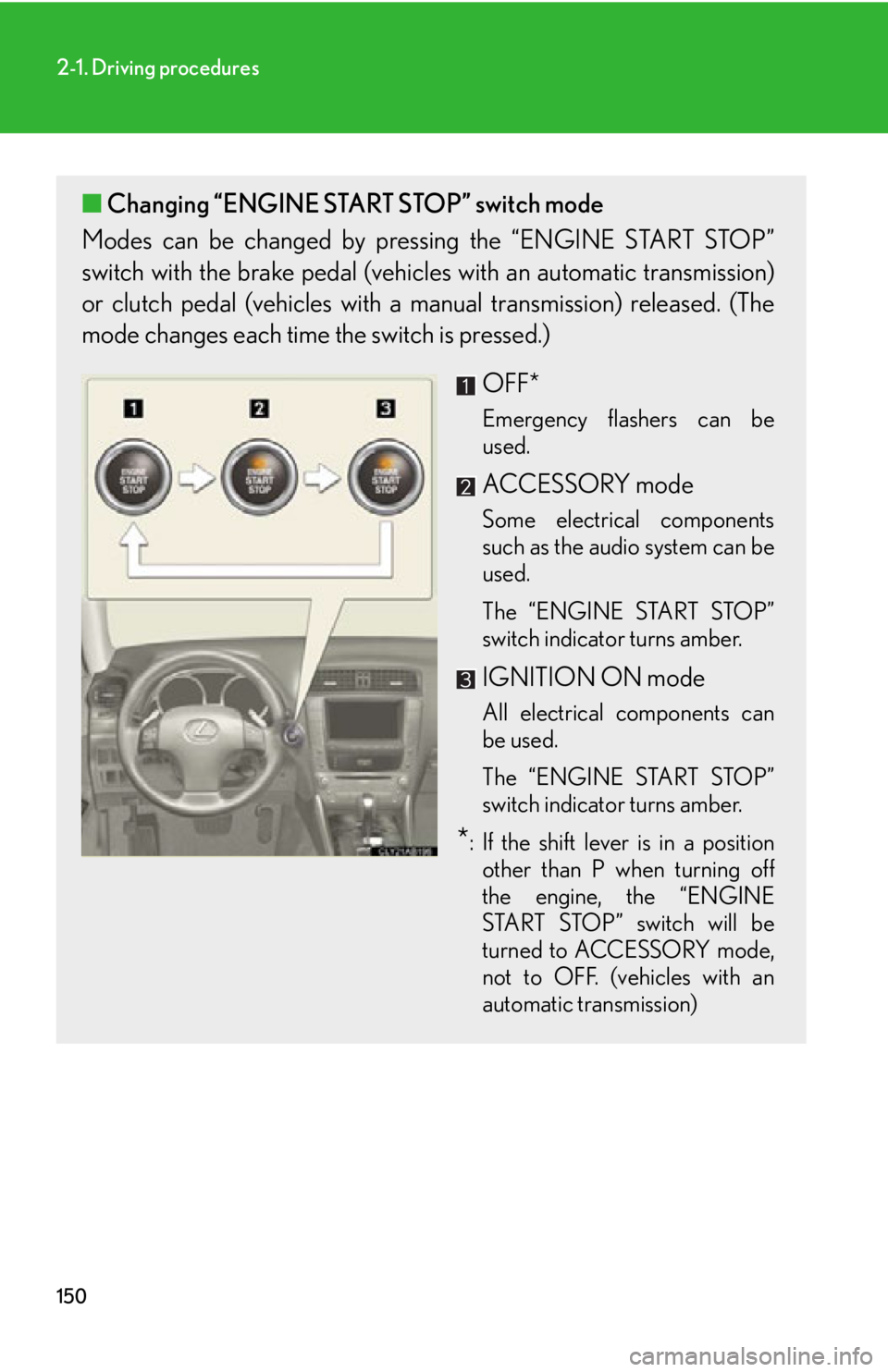
150
2-1. Driving procedures
■Changing “ENGINE START STOP” switch mode
Modes can be changed by pressing the “ENGINE START STOP”
switch with the brake pedal (vehicles with an automatic transmission)
or clutch pedal (vehicles with a manual transmission) released. (The
mode changes each time the switch is pressed.)
OFF*
Emergency flashers can be
used.
ACCESSORY mode
Some electrical components
such as the audio system can be
used.
The “ENGINE START STOP”
switch indicator turns amber.
IGNITION ON mode
All electrical components can
be used.
The “ENGINE START STOP”
switch indicator turns amber.
*: If the shift lever is in a positionother than P when turning off
the engine, the “ENGINE
START STOP” switch will be
turned to ACCESSORY mode,
not to OFF. (vehicles with an
automatic transmission)
Page 244 of 632
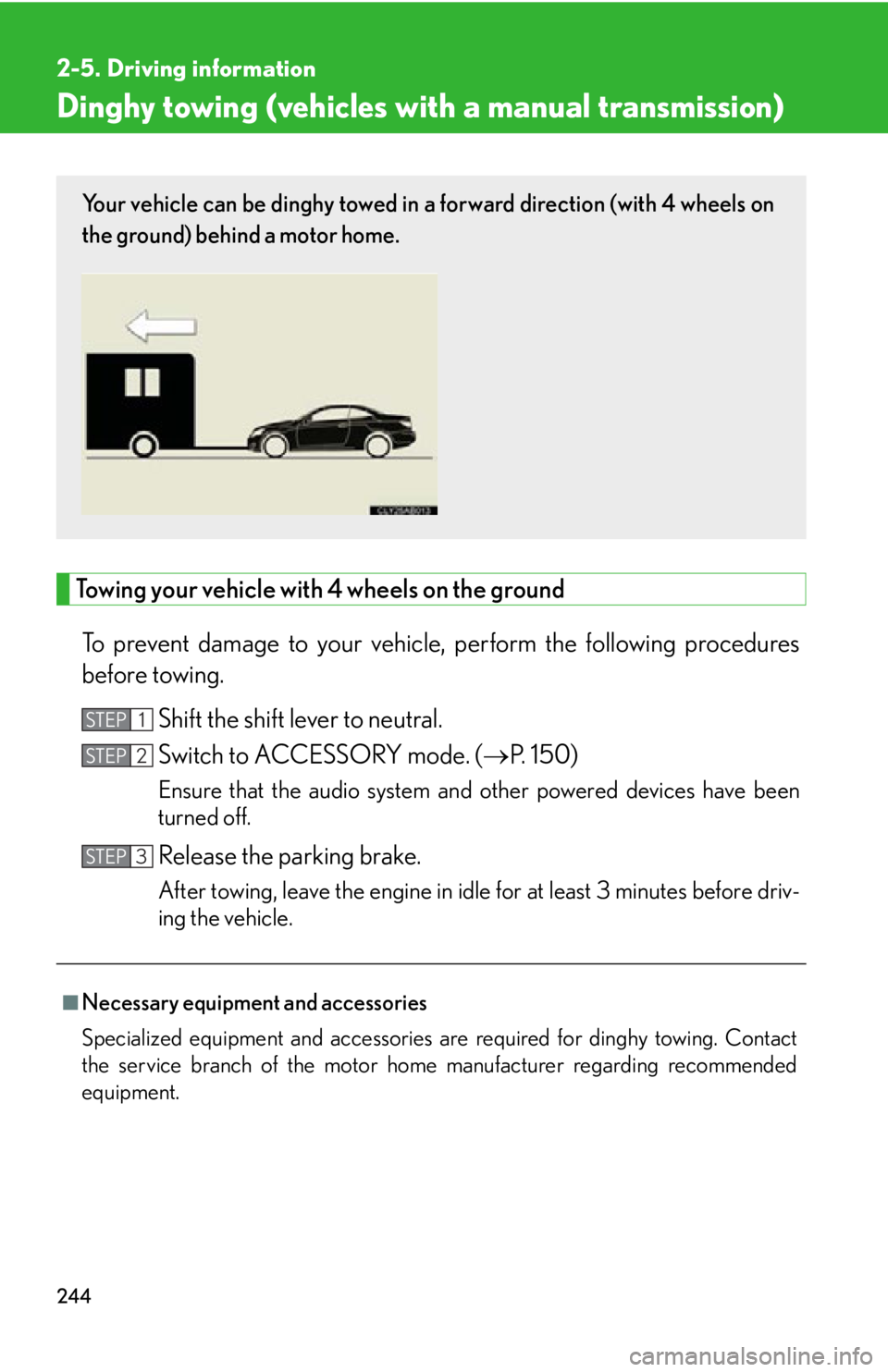
244
2-5. Driving information
Dinghy towing (vehicles with a manual transmission)
Towing your vehicle with 4 wheels on the groundTo prevent damage to your vehicle, perform the following procedures
before towing. Shift the shift lever to neutral.
Switch to ACCESSORY mode. ( P. 150)
Ensure that the audio system and other powered devices have been
turned off.
Release the parking brake.
After towing, leave the engine in idle for at least 3 minutes before driv-
ing the vehicle.
■Necessary equipment and accessories
Specialized equipment and accessories are required for dinghy towing. Contact
the service branch of the motor home manufacturer regarding recommended
equipment.
Your vehicle can be dinghy towed in a forward direction (with 4 wheels on
the ground) behind a motor home.
STEP1
STEP2
STEP3